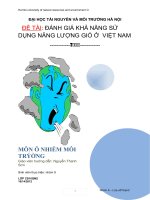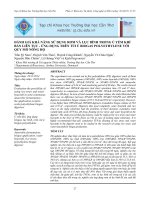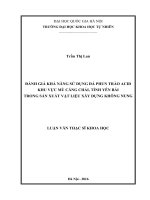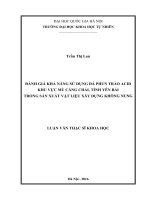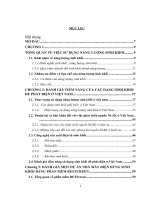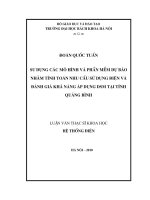Đánh giá khả năng sử dụng các chỉ số hình thái đá tai để định loại một số loài cá biển
Bạn đang xem bản rút gọn của tài liệu. Xem và tải ngay bản đầy đủ của tài liệu tại đây (13.2 MB, 13 trang )
Vietnam J. Agri. Sci. 2022, Vol. 20, No. 9: 1160-1172
Tạp chí Khoa học Nơng nghiệp Việt Nam 2022, 20(9): 1160-1172
www.vnua.edu.vn
Vũ Quyết Thành*, Trần Văn Đạt
Trung tâm Nhiệt đới Việt Nga
*
Tác giả liên hệ:
Ngày nhận bài: 10.05.2022
Ngày chấp nhận đăng: 27.09.2022
TĨM TẮT
Trong bài báo này, chúng tơi đánh giá khả năng định loại một số loài cá biển dựa vào phân tích các chỉ số hình
thái đá tai. Nghiên cứu đã thu thập 180 mẫu đá tai của 10 loài, sau đó tiến hành chụp ảnh, đo kích thước cơ bản
(BSI) và tính tốn các chỉ số hình dạng (ShI) bằng chương trình R. Số liệu được phân tích bằng các phương pháp
xử lý thống kê: ANOVA, Discriminant function analysis (DFA), Canonical Analysis. Kết quả phân tích đã đánh giá khả
năng sử dụng các số đo về hình thái đá tai nhằm xác định lồi. Phân tích DFA dựa vào các số đo cơ bản BSI có thể
xác định 03 lồi ở độ chính xác 100% (18/18); 03 lồi ở độ chính xác cao từ 77-95%. Dựa vào chỉ số hình dạng ShI
có thể xác định được 02 lồi ở độ chính xác 100% (18/18); 03 lồi đạt độ chính xác cao từ 77-89%. Khi kết hợp giữa
số đo cơ bản BSI và chỉ số ShI bằng phân tích DFA tăng khả năng xác định chính xác chung cho 10 lồi là 81,11%.
Số lồi nhận dạng chính xác 100% được tăng lên là 04 loài; 04 loài đạt mức độ phân loại cao từ 77-95%. Kết quả
nghiên cứu cho thấy sử dụng bộ chỉ số kết hợp giữa BSI và ShI cho kết quả phân loại là tốt nhất.
Từ khóa: Đá tai, xác định loài, Discriminant function analysis, số đo cơ bản BSI, chỉ số hình dạng ShI.
Evaluation of the Useability of Morphological Indicators
of Otoliths for Identification of some Marine Fish Species
ABSTRACT
In the present paper, we evaluate the ability to identify some marine fish species based on the analysis of
morphological otoliths. The study collected 180 sagitta of 10 species, then photographed, measured the basic size
indices (BSI), and calculated the shape indices (ShI) in program R. Data were analyzed by standard statistical
methods: ANOVA, Discriminant function analysis (DFA), and Canonical Analysis. The results of the analysis
confirmed the possibility of using measurements of otolith morphology for the purpose of species identification. DFA
based on basic measurements BSI could identify three species with 100% accuracy (18/18); three species with high
accuracy from 77% to 95%. Based on the ShI shape index, 02 species can be identified with 100% accuracy (18/18);
03 species achieved high accuracy from 77% to 95%. When combining the basic measurements of BSI and ShI by
DFA, the overall accuracy of the species was increased by 81.11%. The number of species with 100% accurate
identification was increased to 4 species; 04 species achieved a high classification level from 77% to 95%. Result of
this study showed that combining BSI and ShI gave higest accuracy.
Keywords: Otolith, species identification, discriminant function analysis, measurement index - BSI, shape indices - ShI.
1160
Vũ Quyết Thành, Trần Văn Đạt
1161
Đánh giá khả năng sử dụng các chỉ số hình thái đá tai để định loại một số loài cá biển
1162
Vũ Quyết Thành, Trần Văn Đạt
Tên lồi
Bộ: Perciformes
Ký hiệu
Hình ảnh cá và đá tai
Số lượng mẫu
1CL
18
2CN
18
3CS
18
4CB
18
5CV
18
6CD
18
7CDO
18
8CK
18
Họ: Nemipteridae
Cá lượng Pentapodus setosus
(Valenciennes, 1830)
Bộ: Siluriformes
Họ: Plotosidae
Cá ngát Plotosus lineatus (Thunberg, 1787)
Bộ: Holocentriformes
Họ: Holocentridae
Cá Sơn đá Sargocentron rubrum (Forsskål,
1775)
Bộ: Gobiiformes
Họ: Gobiidae
Cá bống tro Acentrogobius caninus
(Valenciennes 1837)
Bộ: Carangiformes
Họ: Carangidae
Cá chỉ vàng Selaroides leptolepis (Cuvier,
1833)
Bộ: Mugiliformes
Họ: Mugilidae
Cá đối đầu nhọn Crenimugil pedaraki
(Valenciennes, 1836)
Bộ: Carangiformes
Họ: Carangidae
Cá dóc Alepes djedaba
(Forsskål, 1775)
Bộ: Beloniformes
Họ: Hemiramphidae
Cá kìm Hemiramphus sp.
1163
Đánh giá khả năng sử dụng các chỉ số hình thái đá tai để định loại một số loài cá biển
Tên lồi
Bộ: Perciformes
Ký hiệu
Hình ảnh cá và đá tai
Số lượng mẫu
9CM
18
10CMN
18
Họ: Serranidae
Cephalopholis boenak
(Bloch, 1790)
Bộ: Perciformes
Họ: Serranidae
Cá mú vàng nghệ Diploprion bifasciatum
Cuvier, 1828
1164
Vũ Quyết Thành, Trần Văn Đạt
Chỉ số thống kê
BSI
Wilks'lambda
F-remove
P-value
Toler. (1-R2)
1-Toler. (R2)
OL
0,002
32,025
0,001
0,511
0,489
OW
0,005
89,009
0,001
0,638
0,362
P
0,001
5,413
0,001
0,659
0,341
A
0,002
20,512
0,001
0,536
0,464
1165
Đánh giá khả năng sử dụng các chỉ số hình thái đá tai để định loại một số loài cá biển
Lồi cá
Tỉ lệ phân loại
chính xác (%)
1CL
2CN
3CS
4BC
5CV
6CD
7CDO
8CK
9CM
10CMN
1CL
77,78
14
0
4
0
0
0
0
0
0
0
2CN
44,44
0
8
0
4
0
0
0
0
0
6
3CS
72,22
5
0
13
0
0
0
0
0
0
0
4CB
100
0
0
0
18
0
0
0
0
0
0
5CV
83,33
0
0
0
0
15
0
0
3
0
0
6CD
100
0
0
0
0
0
18
0
0
0
0
7CDO
94,44
0
0
0
0
1
0
17
0
0
0
8CK
27,78
0
0
0
0
13
0
0
5
0
0
9CM
100
0
0
0
0
0
0
0
0
18
0
10CMN
38,89
0
7
0
4
0
0
0
0
0
7
Tổng cộng
73,89
19
15
17
26
29
18
17
8
18
13
Lồi cá
1166
Vũ Quyết Thành, Trần Văn Đạt
1167
Đánh giá khả năng sử dụng các chỉ số hình thái đá tai để định loại một số loài cá biển
Chỉ số
Wilks' lambda
F- remove
p-value
Toler. (1-R2)
1-Toler. (R2)
Form factor
0,0028
3,49
0,01
0,69
0,31
Roundness
0,0027
2,64
0,01
0,06
0,94
Aspect ratio
0,0083
45,66
0,01
0,17
0,83
Circularity
0,0051
21,24
0,01
0,40
0,60
Rectangularity
0,0027
2,82
0,01
0,06
0,93
Ellipticity
0,0057
25,39
0,01
0,11
0,89
ShI
1168
Vũ Quyết Thành, Trần Văn Đạt
Lồi cá
Tỉ lệ phân loại
chính xác (%)
1CL
1CL
61,11
2CN
77,77
3CS
2CN
3CS
4BC
5CV
6CD
7CDO
8CK
9CM
10CMN
11
0
2
0
2
0
0
3
0
0
0
14
0
4
0
0
0
0
0
0
44,44
2
0
8
0
6
0
0
2
0
0
4CB
61,11
0
2
0
11
0
0
0
0
0
5
5CV
77,77
1
0
1
0
14
0
0
2
0
0
Loài cá
6CD
100
0
0
0
0
0
18
0
0
0
0
7CDO
88,88
0
0
0
0
0
0
16
0
2
0
8CK
5,55
5
0
5
0
7
0
0
1
0
0
9CM
100
0
0
0
0
0
0
0
0
18
0
10CMN
27,77
0
11
0
2
0
0
0
0
0
5
Tổng cộng
64,44
19
27
16
17
29
18
16
8
20
10
1169
Đánh giá khả năng sử dụng các chỉ số hình thái đá tai để định loại một số loài cá biển
Lồi cá
Tỉ lệ phân loại
chính xác (%)
1CL
2CN
3CS
4BC
5CV
6CD
7CDO
8CK
9CM
10CMN
1CL
77,78
14
0
4
0
0
0
0
0
0
0
2CN
77,78
0
14
0
4
0
0
0
0
0
0
3CS
94,54
1
0
17
0
0
0
0
0
0
0
4CB
100
0
0
0
18
0
0
0
0
0
0
5CV
83,33
0
0
0
0
15
0
0
3
0
0
6CD
100
0
0
0
0
0
18
0
0
0
0
7CDO
100
0
0
0
0
0
0
18
0
0
0
8CK
50
0
0
0
0
9
0
0
9
0
0
9CM
100
0
0
0
0
0
0
0
0
18
0
10CMN
27,78
0
9
0
4
0
0
0
0
0
5
Tổng cộng
81,11
15
23
21
26
24
18
18
12
18
5
Lồi cá
1170
Vũ Quyết Thành, Trần Văn Đạt
Allen G.R., Steene R., Humann P. & Deloach N.
(2003). Reef Fish Identification Tropical Pacific.
New World Publications, Inc.
Bani A., Poursaeid S. & Tuset V.M. (2013).
Comparative morphology of the sagittal otolith in
three species of south Caspian gobies Journal of
Fish Biology. 82: 1321-1332.
Begg G.A., Friedland K.D. & Pearce J.B. (1999). Stock
identification and its role in stock assessment and
fisheries management: anoverview. Fisheries
Research. 43: 1-8.
Campana S.E. (2004). Photographic atlas of fish
otoliths of the Northwest atlantic ocean. Canadian
Special Publication of Fisheries and Aquatic
Sciences. No 133. NRC Research. press.
/>Falini S., Fermani S., Vanzo M. & Miletic G. (2005).
Influence on the formation of aragonite or vaterite
by otolith macromolecules. European Journal of
Inorganic Chemistry. pp. 162-167.
Froese R. & Pauly D. (2022). FishBase - World Wide
Web electronic publication. Retrieved from
www.fishbase.se on Jan 18, 2022.
Hà Phước Hùng & Hồ Kim Lợi (2013). Nghiên cứu
hình thái đá tai của họ cá Chép (Cyprinidae) phân
bố ở An Giang và Cần Thơ. Tạp chí Khoa học,
Trường Đại học Cần Thơ. 26: 50-54.
1171
Đánh giá khả năng sử dụng các chỉ số hình thái đá tai để định loại một số loài cá biển
He T., Cheng J., Qin J., Li Y. & Gao T. (2017).
Comparative analysis of otolith morphology in
three species of Scomber. Ichthyological Research.
65: 192-201.
Kimura S., Imamura H., Nguyen V.Q. & Pham T.D.
(2018). Fishes of Ha Long Bay, the natural heritage
site in northern Vietnam. Fisheries Research
Laboratory, Mie University, Shima, Japan.
Levia D., Andreolib M.G., Arneric E., Giannettic G. &
Rizzoa P. (1994). Otolith reading as a tool for stock
identification. Fisheries Research. 20(2): 97-107.
/>Libungan L.A. & Pálsson S. (2015). ShapeR: An R
package to study otolith shape variation among fish
populations. PLoSOne. 10(3): Article e0121102.
Retrieved
from
/>journal.pone. 0121102 on Feb 18, 2022.
Lieske E. & Meyers R. (1996). Coral Reef Fishes
(Caribbean, Indian Ocean and facific Ocean
including the Red Sea). Princeton University
Presss, America.
Lin C., Gracia B.D., Pierotti M.E.R., Andrews A.H.,
Griswold K. & O’Dea A. (2019). Reconstructing
reef fish communities using fish otoliths in coral
reef sediments. PLoSOne. 14(6): Article e0218413.
Retrieved from />pone.0218413 on Jan 26, 2022.
Lin Y.J. & Al-Abdulkader K. (2019). Identification of
fish families and species from the western Arabian
Gulf by otolith shape analysis and factors affecting
the identification process. Marine and Freshwater
Research. 70: 1818-1827.
Nakabo T. (2002). Fishes of Japan with pictorial keys to
the species, English. Tokai University Press, Japan.
Oliveira A.M. & Farina M. (1996). Vaterite, calcite and
aragonite in the otoliths of three species of piranha.
Naturwissenschaften. 83: 133-135.
1172
Portnoy D.S. & Gold J.R. (2013). Finding Geographic
Population Structure in Marine Fish Species with
High Gene Flow. Proceedings of the 65th Gulf and
Caribbean Fisheries Institute. 65: 384-389
Salimi N., Loh K.H., Kaur Dhillon S. & Chong V.C.
(2016). Fully-automated identification of fish
species based on otolith contour: using short-time
Fourier transform and discriminant analysis
(STFT-DA). PeerJ 4:e1664. Retrieved from
on Jan 18, 2022.
Tuset V.M., Lombarte A. & Assis C.A. (2008). Otolith
atlas for the western Mediterranean, north and
central eastern Atlantic. Scientia Marina.
72(1): 7-198.
Tuset V.M., Lozano I., Gonzalez J., Pertusa J. &
Garcia-Diaz M. (2003) Shape indices to identify
regional differences in otolith morphology of
comber, Serranus cabrilla (L., 1758). Journal of
Applied Ichthyology. 19: 88-93.
Vu Quyet Thanh & Kartavtsev Yu. Ph. (2017).
Morphometric differences between two smelt
species, Hypomesus japonicus (Brevoort, 1856)
and H. nipponensis (McAllister, 1963) (Pisces:
Osmeridae) from the Northwestern part of the Sea
of Japan. Russian Journal of Marine Biology.
43(6): 436-446.
Vu Quyet Thanh & Kartavtsev Yu. Ph. (2021). Otolith
shape analysis and its utilily for identification of
two smelt species, Hypomesus japonicus and
H. nipponensis (Osteichthyes, Osmeridae) from the
northwestern Sea of Japan with inferences in stock
discrimination of H. japonicus. Russian Journal of
Marine Biology. 46(6): 431-440.
Vũ Quyết Thành, Trần Văn Đạt, Phùng Văn Giỏi, Trần
Văn Hướng & Trần Cơng Thịnh (2022). Mơ tả
hình thái đá tai (sagittal) của một số lồi cá rạn san
hơ tại vùng biển Cát Bà và Thổ Chu. Tạp chí Khoa
học Nông nghiệp Việt Nam. 20(5): 603-613.


